-
-
-
|
-
Samoa Map
Map of Upolu
-
|
-
-
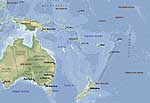
-
-
-
Map of
-
the Pacific
-
|
-
-
-
-
-
|
- latest picture: April 29, 2009
- click a picture to see details
|
-
-

|
-
-
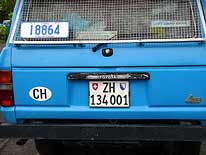
|
-
-

|
- 01
On April 1st, 2009, in the port of
- Apia, Emil is driving our LandCruiser
- – arriving from Fiji – out of its
- 15th container into its 163rd country
|
- 02
Our LandCruiser gets a Samoan
- license plate. "Penina ole Pasefika"
- means "Pearl of the Pacific"
|
- 03
The white Catholic Cathedral on
- the city's waterfront is a glooming
- landmark of Samoa's capital Apia
|
-
- It is 1.30am of March 31st, 2009, a day that we regain due to the crossing of the date
line during our Air Pacific flight from Fiji to Samoa, from
Melanesia to Polynesia. Somewhat weary from the night flight, we enter the terminal and
are surprised and pleased to see that a 5-men-band is still welcoming newcomers with
Polynesian music at this early morning hour. Immigration is fast and smooth; we get a two
months’ stay stamped into our passports. Then we grab our only bag that is already on
the conveyor belt and hesitate: Shall we take the green exit (nothing to declare) or the
red one?
|
-
-

|
-
-
-
-
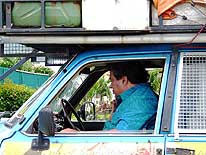
|
-
-

|
- 04
Honourable Misa Telefoni,
- Deputy Prime Minister of Samoa,
- introduces us to the press .....
|
- 05
.....and is eager to drive
- our Guinness Record LandCruiser
- for one kilometer through the
- city of Apia
|
- 06
We drive through the
- arch of "The treasured Island
- of the South Pacific" in Apia
|
-
- Our indecision is caused by Emil, who by no means did want to leave behind a piece of
cheese from Fiji that we could not finish. Knowing that on
all Pacific islands, cheese belongs to the forbidden
items to import, we cautiously mentioned it on the customs form. So where to now:
“Red” or “green”? While we are still arguing about it, a lady customs
officer from the “green line” who attentively watches the exiting passengers,
waves us to her side. Our “cheese problem” turns out to be no problem at all,
because it is originating from New Zealand.
|
-
-
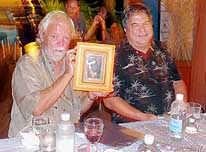
|
-
-

|
-
-

|
- 07
Honorable Misa Telefoni, Deputy
- Prime Minister of Samoa, is presenting
- Emil a souvenir of Samoa – a framed Fish
- Hook – at a dinner in the "Sail" Restaurant
|
- 08
The "Fale Fono" – Samoa's
- parliament house – sits at the
- Mulinu'u Peninsula, which stretches
- to the northwest of central Apia
|
- 09
The Clock Tower is the center
- of Apia. It was constructed in
- memory to the fighters and to those
- who lost their lives in WW1
|
-
- The ATM at the airport does not work – we change a few dollars to be able to pay
the taxi to drive us the 22 miles to the capital Apia, where we booked a room in the
Tatiana budget hotel. At the reception, there is a lady waiting, a bit sleepy though, but
friendly. “We have upgraded you and put you in a better room on the 1st floor for the
same price”, she welcomes us. Things seem to start rolling really well! We collapse
onto the two comfortable beds in our spacious air-conditioned room with toilet and shower
and realize only later that we are facing directly the busy road. Often we have the
impression that the traffic rolls straight away through our room. Accordingly, we are
still tired when we get up, but enjoy our rich self service breakfast consisting of banana
and papaya, butter and marmalade, cornflakes and cracker, milk, tea and coffee.
|
-
-

|
-
-

|
-
-
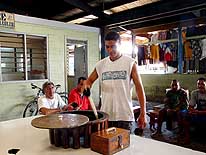
|
- 10
Saturday afternoon at the central
- bus terminal at "Maketi Fou" – the
- fresh produce market: People are
- waiting patiently for their transport .....
|
- 11
..... the bus to Saleimoa
- arrived and people are boarding
|
- 12
It is Kava time at "Maketi Fou".
- Kava is a stimulating beverage that
- belongs traditionally to all
- Pacific islands
|
-
- “The ‘Tropical Islander’ – the ‘Greater Bali Hai’ vessel
with our LandCruiser’s container on board – has already berthed and started to
unload”, informs us Hugo, the manager of Betham Brothers, our shipping agent, whom we
pay our first visit. “I suggest you come tomorrow at 9am for the car release
procedures”, he adds. As it is raining, we walk straight back to our hostel and buy
our lunch – a frozen Hawaiian Pizza – at the Farmers Jo Supermarket nearby.
After we moved into a quieter room, we put the pizza into the microwave, which in Samoa in
most of the hostels belongs to the standard equipment. “Have you seen the two bottles
of Gordon Gin from Fiji's duty free shop”, Emil asks
when it is time for out traditional gin tonic aperitif?” We look everywhere, even in
the old room, but it is nowhere. “I don’t believe it!” grumbles Emil.
“We left it behind in the taxi. We are slowly getting old”.
|
-
-

|
-
-
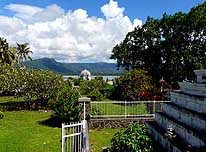
|
-
-

|
- 13
Tombs of kings are spread out
- at the Mulinu'u Peninsula northwest
- of central Apia. Here rests
- Malietoa Tanumafili II .....
|
- 14
..... and at the tip of the Peninsula
- are the seven-tiered tomb of the
- Tu'imaleali'ifano dynasty and the
- mausoleum of Tupua Tamasese
|
- 15
The white turreted church at
- Vaipuna in Apia is a beautiful sight
|
-
- Next morning, we are standing with a positive feeling in front of our 15th container. It
is always an uncertain moment of getting our LandCruiser unharmed back, because such a
container is moved several times around. Everything is proceeding fast and smoothly. The
only thing we are asked by the quarantine is to have our car steam cleaned – this is
their rule. One hour later, we are already driving out of the port. All fees have been
waived – customs, quarantine and port – what a most appreciated surprise.
What’s left now is the vehicle registration office, where we will have to get
temporary local license plates and pay the road taxes.
|
-
-
-
-

|
-
-

|
-
-

|
- 16
In the flowering garden of the
- Le Manumea Hotel in Vailima, every
- morning and every evening this
- beautiful Cardinal pays us a visit
|
- 17
The Ginger plant in its
- deep red color is one of the
- most fascinating flowers
- of the tropics
|
- 18
This black crested
- endemic red-vented
- Bulbul is very curious
- and relatively tame
|
-
- However there is no favored treatment. As everybody else, we have to queue up with our
agent for two hours until it is our turn. And as everybody else, we have also to pay the
full yearly tariff of around US$200 despite that we will remain only three months in the
country. But we do not want to complain, because we are more than grateful that the
country’s Cabinet exceptionally accepted to admit our left hand driven vehicle
temporarily. Any such import has been recently banned due to the fact that in September
the island will change from right to left hand drive – a much discussed and hot
subject. After buying a local driver’s license and having fixed our brand new license
plates with the number “18864” to our LandCruiser, we are ready to explore the
“Treasure Island of the South Pacific”, or “The Pearl of the Pacific”, as it is also called and written on the
plates.
|
-
-

|
-
-

|
-
-

|
- 19
A lovely sunrise announces a new
- day on the island of Upolu in Samoa
|
- 20
Girls are practicing for their
- dance performance behind the
- Tourist Office in Apia .....
|
- 21
..... and the men are practicing
- for races in 45-man canoes held on
- special occasions, e.g. during the
- independence celebrations on June 1st
|
-
- “In Samoa, the world seems still to be intact!” This goes through our mind
when we step into the anteroom of the Deputy Prime Minister, Hon. Misa Telefoni, without
being checked and screened. We want to express our gratitude and appreciation personally
for all his support regarding our car’s entry permit. Shortly after, we already sit
in his office in front of a cup of coffee. After Yemen und Guyana, it is the third time that we are greeted at such a
high level, except in Kuwait maybe, where Emil was
invited to a Sheik to attend an Ambassador’s farewell.
|
-
-

|
-
-

|
-
-

|
- 22
The unique flair of Polynesia is
- awaiting us at the legendary Aggie
- Grey’s Lagoon Beach Resort & Spa
- at the Northwest coast of Upolu. We
- are invited there for two nights .....
|
- 23
..... sleep in a deluxe room
- facing the Pacific Ocean and
- enjoy the beautiful exotic flower
- arrangements on our beds .....
|
- 24
..... and the lonely sand beach at
- the far east corner of the Hotel Resort
|
-
- The conversation is very relaxed. And in the short available time before his next
meeting, Hon. Misa Telefoni gives Nora, his secretary, the order to arrange a press
conference for tomorrow. Casually he remarks that he will arrange for us a couple of
nights to a minimum cost in some luxury resorts and expresses his wish to be allowed to
drive our widely traveled LandCruiser for at least one mile. Additionally, he
spontaneously invites us to a personal dinner with friends for next Saturday. In Samoa not
only the world seems to be still intact, but it appears to be full of surprises too.
|
-
-

|
-
-

|
-
-

|
- 25
The Museum of Robert Louis
- Stevenson, Scottish author, who made
- Samoa his second home and who spent
- his last five years in this beautiful
- residence four miles South of Apia .....
|
- 26
..... His last wish was to be
- buried at a plateau just below the
- summit of the “Mount Vaea Scenic
- Reserve” – a one hour steep trek
- through the forest. This was 1894
|
- 27
View from Robert Louis
- Stevensons’s Tomb over the
- harbor and the city of Apia,
- capital of Samoa
|
-
- The press conference is taking place in the open behind the tourist office. At least,
the rain has stopped, which has bothered us since our arrival. It is a very unique moment
when Hon. Misa Telefoni climbs onto the driver’s seat of our LandCruiser, with Emil
as co-driver, and off they go together. For the cameramen of the two TV stations and the
journalists it is peak time. After a while, the two return smiling. “You should have
seen the face of the policeman when he realized WHO is sitting behind the steering wheel
of this ‘funny’ car”, recounts Emil. “He could not stop staring after
us with his mouth left open”. It is one of those happenings that make us smiling
whenever we remember it.
|
-
-

|
-
-

|
-
-

|
- 28
Samoa has one of the biggest con-
- centrations of churches of any kind we
- have ever seen. This is the treasure of
- Fasitoouta near the airport of Faleolo
|
- 29
Children, all dressed in
- spotless white, sit outside a church
- in Apia during Sunday mass
|
- 30
Another of the plentiful
- churches that shape Samoa
|
-
- Saturday, we put on our newly ironed best dresses and head for the Sails Restaurant at
the seashore for the private dinner with Hon. Misa Telefoni and his wife, Ms. Sarah
Retzlaff. The place of honor is taken by Christiane and Herwig Niggemann, Germans from
Bochum, who have published a small picture book “Samoa 1904” with old photos
from Otto Tetens, the brother of Christiane’s grandfather, who traveled to Samoa in
1902 to build the Apia Observatory. It is an impressive collection that shows the way
Samoan people lived 100 years ago.
|
-
-

|
-
-
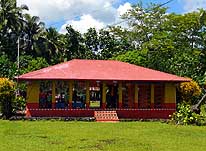
|
-
-

|
- 31
Both are impressive: The oval
- Meeting Hall in the Head of State’s
- compound as well as the
- huge tree beside it
|
- 32
A typical more modern home
- in Samoa. It consists of one room,
- just with pillars without exterior
- or interior walls to maximize the
- cool breezes inside
|
- 33
A relaxed picnic at the sea shore
|
-
- With exquisite food we spend a relaxed evening. Emil and I enjoy striploin steak with
pepper sauce, vegetables and potatoes as main course, while the other guests prefer garlic
prawns with ginger, rice and salad. The other invitees are: Former Tourism Minister Hans
Joachim Keil with his wife, and our Swiss Honorary Consul-General Marco Kappenberger with
his wife. We are the last ones leaving in heavy rain and returning this time to the
up-market Le Manumea Resort Hotel at the foot of Mt. Vaea, where, through intervention of
our today’s host, we will be staying for an entire week in an own spacious garden
bungalow with an outdoor (!) bathroom.
|
-
-

|
-
-

|
-
-

|
- 34
Near the pass of the „Central Cross
- Island Road” stands the” Baha’i House
- of Worship” with its 62ft. high dome. It is
- one of the eight such temples in the world
|
- 35
From the “Central Cross Island
- Road” a sweeping view opens to
- the palm fringed South coast
|
- 36
Locals pose spontaneously
- for a picture
|
-
- After the last eventful days, it is getting quieter around us. And after the long
lasting rain, finally also the sun is shining again. We are eager to explore the
surroundings and head to the nearby forest of Mt. Vaea, where the Scottish author Robert
Louis Stevenson spent the last five years of his life and is buried at a platform below
the peak. We can imagine how difficult it must have been to carry his coffin up the steep
narrow forest path to his last resting place, when it takes even us one strenuous hour to
get there from his mansion, which has been transformed into a museum. From his grave we
enjoy the lovely view over the capital.
|
-
-

|
-
-

|
-
-

|
- 37
The Togitogiga waterfall on the
- South coast plunges in two levels
- into refreshing pools
|
- 38
A single yellow star charms this
- white blossom. These flowers are
- especially suitable for decorations
|
- 39
The tiny tropical island of
- Nuusafee on the South coast
- protrudes from the Pacific Ocean
|
-
- Apia, Samoa’s Capital with its provincial character is the most attractive along
the water front. The harbor wall stretches more than a mile to the tip of the Mulinuu
peninsula, where the parliament house and also some tombs of ancient kings are located.
But along this seashore it is also more or less the only spot where we can pitch up our
camping table and chairs and enjoy our lunch without being afraid of being on private
land. Because on one occasion we experienced a rather embarrassing situation: Misguided by
a road sign saying “Reserve”, we entered a gate and suddenly landed in the
unguarded premises of the Head of State.
|
-
-

|
-
-

|
-
-

|
- 40
This traditional modest thatched
- house (Fale) with its simple meeting
- place is a harsh contrast .....
|
- 41
..... to the monumental new
- church with its modern meeting
- houses standing right next to it
|
- 42
Still the traditional Samoan
- way: A home, open to all sides,
- with blinds woven from palm
- leafs to shut down during the night
|
-
- Only through the two watchmen who immediately showed-up we realized where we are. We
expressed our apologies and started to pack-up. To our big surprise, the more competent of
the two suddenly said: “It is not a problem; you are welcome to eat your lunch
here!” We could hardly believe it – neither scolding nor a charge, simply
nothing. This can happen only in extraordinary Samoa! As it is the case on all of the Pacific Islands, the “private land system”
applies also in Samoa, i.e. every square inch is family owned, what makes it not only
impossible to camp but also very difficult to roam around freely.
|
-
-

|
-
-

|
-
-

|
- 43
On the Southern side of the „Le
- Mafa” Pass the spectacular 177ft. high
- waterfall Sopoaga plunges through dense
- rainforest into an impressive gorge
|
- 44
Very green is the landscape
- from the “Le Mafa” pass towards
- Falefa on the Northeast coast .....
|
- 45
..... with an amazing
- looking vegetation
|
-
- Unique in its construction are the traditional houses, called “Fale” –
the landmark of Samoa. They are round or square in shape with a high thatched roof
supported by wooden posts. There is only one room, without outer and inner walls in order
to allow the flow of the cool sea breeze. For privacy or in the event of rain, woven
blinds made of coconut leaves can be lowered. Nowadays, modern houses prefer to use
curtains. These structures dominate the landscape and villages of this peaceful Pacific
island; they serve not only as homes, but also as primary class rooms and especially
meeting places. With their posts painted in different colors and surrounded by much cared
tropical plants and flowers, they are always a lovely sight. Samoa often looks like a huge
exotic garden to us, and the red, green and yellow seem to be more intensive than
elsewhere. It is also the cleanest Pacific island that we have visited so far.
|
-
-

|
-
-

|
-
-

|
- 46
One of the beautiful coastal
- views near Vailele on the North coast
|
- 47
Despite of the afternoon heat,
- women are playing fistball
- on their sport field
|
- 48
Preparing to thatch a roof with
- palm leaves the traditional way. Four
- layers are used. A thatched roof keeps
- a place cooler than a corrugated iron
- roof but needs much more maintenance
|
-
- The deep-rooted customs – the ‘Fa’a (the Samoan way of life) – are
still widely used. The villages are built on common land of extended families. Everything
is communal. People deliver their earned money and merely receive some
‘peanuts’. There is no “I”, only “We”, what – to our
opinion – reduces the motivation to work harder and gain consequently more. On the
other hand, everyone is looked after. The head of each village is a “Matai”
(chief). Together with his council he makes the rules, discusses problems and arbitrates
over disputes. He is also maintaining peace, order and discipline, especially among young
people, and watching that the evening prayers are observed by everyone. Every night –
mostly around 6pm – the church bell (usually an empty propane tank is hit with a
stick or a conch shell is blown) sounds three times. At the first struck of the bell, all
activities cease. At the second each family gathers for evening prayer and at the third
one the prayer is over. Interesting is also to discover that outside of Apia town there is
hardly any police, may be once in a while a patrol car. All difficulties are tried to be
solved within the village community.
|
-
-

|
-
-

|
-
-

|
- 49
People leaving the church in their
- fabulous white dresses after a Sunday
- mass is always a most beautiful sight
|
- 50
View from the „Theological
- College“ of Malua direction
- East towards Saleimoa
|
- 51
Marching of the “Royal Police
- Band of Samoa” from the police
- station in Apia to the Government
- building: The flag rising ceremony
- is daily (working days) while the
- national anthem is played too
|
-
- Religion still plays a vital role in Samoan life and the pastor carries the status of a
“Matai” (chief). In no other countries we have seen such an accumulation of
imposing churches. The communities seem to compete with each other in the size and
elaborate architecture. They are a striking contrast to the simplicity of the homes. It
can easily happen that in a small village there is up to three churches, standing
side-by-side, each one more impressive than the neighbor. Each community wants to show its
wealth. In a way, we have a problem with it considering the modest houses of the islanders
in comparison, who also take turns in providing food to their pastor and contribute large
amounts of money to their church (up to 30% of their income – we were told). Sunday
is sacred and is spent with the family. Together they attend the mass. For us, it is
always a joyous moment seeing the church goers in their spotless white dresses, and it is
also always an experience to listen to their beautiful chanting through the open church
doors. Except for established hotels and restaurants, in most of the Pacific islands alcohol is also prohibited to be sold on
Sundays, be it because of a possible abuse or for religious motives.
|
-
-

|
-
-
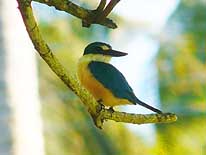
|
-
-

|
- 52
Our house on the seashore in
- Puipaa, 4 miles west of Apia,
- which we rented for a couple
- of weeks. Camping isn’t possible
- in Samoa, and spending the nights
- in hostels gets more expensive
|
- 53
„Our“ Kingfisher that is
- always sitting on the same tree
- and on the same branch beside
- our house (see the white
- Kingfisher in
- American Samoa (picture 14)
|
- 54
A lonely fisherman gliding
- silently in front of our house
- through an almost
- mirror-calm sea at sunrise
|
-
- On Easter Sunday, we change once more our accommodation – from Le Manumea Hotel to
the “Aggie Grey’s Lagoon & Beach Resort” in the Northwestern part of
the island, where we are able to enjoy all the luxury for two nights – and once more
at a reduced rate. Here we encounter some of the romantic South Pacific atmosphere
remembering from our short-term vacations back in the 1970’s, when we traveled
through the Pacific islands more than once: Palm trees,
a turquoise lagoon and a white sandy beach. Our room is decorated with a profusion of
tropical flowers – beautifully arranged on the two king size beds and the table. And
in the bathroom red Hibiscus flowers are glooming from every corner. It is a lovely
welcome! From June to September the whole hotel complex, which normally is booked mainly
by package tours from New Zealand, is rented out to the American television network CBS
for their 19th episode of the “Survivor” series.
|
-
-

|
-
-

|
-
-

|
- 55
|
- 56
|
- 57
|
- The sunrises in front of our house show each day a new spectacular picture
|
-
- The name “Aggie Grey” derives from a courageous American lady, who in 1942 in
World War II sold hamburgers and coffee to US solders in order to feed her family. This
made her known throughout the Pacific region. Her snack corner was the social meeting
point of war tired solders. Some decades later, she expanded her “burger bar”
into a hotel – the„Aggie Grey’s Hotel & Bungalows“ in Apia. Still
today “Aggie’s” is a legend, where after more than 60 years bungalows are
still named after visiting celebrities like Marlon Brando or Roberta Haynes. Aggie Grey
died 1988 aged 91. The „Aggie Grey’s Hotel & Bungalows“ in the town of
Apia, as well as the „Aggie Grey’s Lagoon & Beach Resort“ near the
airport, respectively near the ferry terminal to Savaii, are now managed by her nephew Frederick Grey.
|
-
-

|
-
-

|
-
-

|
- 58
The traditional „Fale“ on poles
- without walls dominate the look of
- Samoa. They are used as gathering
- places (in Siufaga – Southwest) .....
|
- 59
..... or as family homes
- (in Falelatai – Southwest) .....
|
- 60
..... and also as school
- rooms for lower classes
- (in Fasitoouta – Northwest)
|
-
- As it was already the case in New Caledonia, Vanuatu and Fiji, we spend also
three months in Samoa in order to “amortize” the hefty shipping and airline
costs of our Pacific island hopping. But the thought to
have to move back to the cheap budget accommodations for the remaining ten weeks –
and cheap means at least US$45 a night for a double room, does not make us happy. Why not
try to rent an affordable apartment or even a house? We start investigating. Luck has it
that one of the furnished houses of the Deputy Prime Minister in Puipaa – approx. 4½
miles West of Apia – is vacant at the moment, and he is willing to rent it out to us
for the required period for a price that costs us half of what we would have paid in a
budget hotel.
|
-
-

|
-
-

|
-
-

|
- 61
View over the Fagaiofu Bay in
- the Southwest (and in the background
- the sister island of Savaii) .....
|
- 62
..... where in the village of
- Falelatai stands one of the most
- beautiful monumental churches,
- which are nearly as numerous
- in Samoa as the “Fale“
|
- 63
The setting of the “Return to
- Paradise Beach” in the Southwest
- comes already very close to our vision
- of a Pacific paradise. It got its name
- from the shooting of James Michener’s
- novel “Return to Paradise” in 1951,
- starring Gary Cooper
|
-
- It is situated directly at the seashore, has a living room, three sleeping rooms, a
shower with hot water, a kitchen and a porch. We like it at first sight. And being able to
access also internet via Lesamoa.net, we move in on April 15th. It contains everything we
need, even a washing machine. Very soon we make acquaintance with our surroundings: With
the yellow-blue king fisher that is sitting always on the same tree, with the curious
bulbul birds, with a red-black cardinal that feeds on the red hibiscus flowers, with the
nearly flightless buff-banded rail (a kind of a small chicken) that is looking for food
all day long on the lawn and with the smart mynas that appear in groups and seem to
chatter all day long.
|
-
-
-
-

|
-
-

|
-
-
-
-

|
- 64
Sitting in the refreshing sea
- makes washing the laundry by hand
- in the tropical heat less strenuous
|
- 65
A father is fishing with his
- two children. Each time a wave
- approaches, the little girl grabs
- fearfully her father’s leg
|
- 66
A fisherman is banging with his
- stick onto the water surface in order to
- chase the fishes into his laid out net
|
-
|
-
- Continuations from Samoa:
-
|
- Articles in newspapers about us in Samoa:
- Article: "Switzerland couple have
travelled to 163 countries", Daily Newspaper "Samoa
Observer" - April 5, 2009
- Article: "World
travellers take fond memories", Daily Newspaper "Samoa
Observer" - July 1, 2009
|
|
![]()